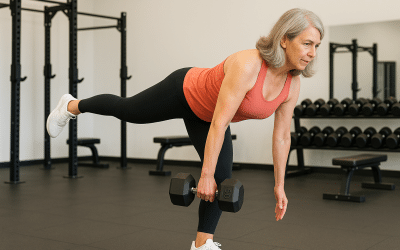| Mistake | Why it matters | Quick Fix |
|---|---|---|
| Using weights that are too light | No Type II fiber stimulus → stalled strength | Pick a 6-10-rep load |
| Rushing every rep | Zero time-under-tension, poor joint control | Control each rep both up and down |
| Skipping compound moves | Misses bone-loading synergy | Add squats, rows, pushes |
Most workout mistakes for women over 50 come from one of two places:
- Bad advice
- Good intentions paired with a bad plan
I’ve worked with hundreds of women in their 50s, 60s, and beyond. Some were brand new to strength training. Others had been hitting the gym for years but still hadn’t seen much change.
And in almost every case, they were making the same three mistakes – just packaged differently.
Let’s walk through them.
And more importantly, let’s fix them.
Workout Mistake #1: Using the Same Weights for Months (or Years)
The single most common mistake I see?
Not enough resistance.
You can’t maintain muscle—let alone build it—without a challenge. That means your body needs to be exposed to more over time, not the same.
Here’s what this looks like in the real world:
- You’ve been doing the same 3 sets of 12 reps with the same dumbbells since pre-COVID
- You say, “These feel heavy enough” because they did when you first started
- You avoid heavier weights because you’re afraid of getting hurt
I get it. Especially with joint pain, it feels safer to stay in a comfort zone.
But that comfort zone is where your progress dies.
A real example:
Karen (not her real name) came to me frustrated. She was lifting weights 2–3x/week and hadn’t seen results in years. She was stuck using 8 lb dumbbells and assumed anything heavier would hurt her shoulder.
We made just three changes:
- Improved her shoulder mobility
- Reinforced proper pressing mechanics
- Gradually increased load every 1–2 weeks
By week 6, she was pain-free and overhead pressing 20 lbs per hand.
By week 8, she could carry her 30 lb dog up the stairs—something she hadn’t done in years.
Expert Tips:
– Write down the weights you’re using. If they haven’t increased in the last month, that’s a red flag.
– Don’t chase fatigue. Chase performance.
– Strength is earned with progression, not repetition.
Workout Mistake #2: Feeling Sore in the Wrong Places
Here’s something most programs get wrong:
Just because a movement looks “functional” doesn’t mean it’s safe for your joints.
Soreness is fine. But it needs to be the right kind of soreness.
You want muscles to feel worked—not knees, hips, or spine.
Common red flags:
- Knee pain after squats
- Shoulder pinching during rows or presses
- Low back ache after deadlifts or “core” exercises
I see this constantly with women coming from bootcamps or random online workouts. Too much volume, too little control.
Here’s the thing: joint pain is often a result of the muscles around the joint not doing their job. And that’s almost always a programming issue.
Expert Tips:
– Lock it in.
Brace core, set shoulder blades, tweak stance until the joint feels neutral.
– Prime support.
One quick activation set for stabilizers—glutes, mid-back, deep abs—before loading up.
– Audit pain.
If a lift sparks joint ache twice, swap it for a muscle-focused alternative.
Workout Mistake #3: No Tangible Progress in 6–8 Weeks
If you’re not getting better at something, you’re not training. You’re just moving.
Most women over 50 were told to “just stay active.”
But movement without purpose doesn’t build strength. It doesn’t protect joints. It doesn’t reverse muscle loss.
And it certainly doesn’t improve bone density or metabolic health.
Strength training should translate into real-world function.
Climbing stairs without grabbing the railing.
Carrying groceries in one trip.
Getting off the floor without assistance.
Ask yourself:
- Am I lifting heavier than I was two months ago?
- Is it easier to bend, squat, or get up from a chair?
- Do I feel more capable in my day-to-day life?
If not, something needs to change.
Expert Tips:
– Build your workouts around movement patterns, not muscle groups:
Push Pull Rotate | Shift your center of gravity | Work on one leg
– Stop chasing random variety. Start chasing performance.
– Set specific goals and audit progress every 4–8 weeks.
Monthly Progress Check-In
Are you making progress, or just going through the motions?
Check all that apply from the last 4–8 weeks:
Monthly Progress Check-In:
Check all that apply from the last 4–8 weeks.
Why These Mistakes Happen
Didn’t check at least two boxes?
That’s your signal. You need a better plan.
These aren’t just user errors.
Most workout programs marketed to women over 50 are either:
- Too light
- Too chaotic
- Or built around fear instead of function
There’s a huge gap between what feels familiar and what actually works—especially with joint pain, fatigue, and recovery limitations in the mix.
Bottom Line
The most common workout mistakes for women over 50 aren’t about effort.
They’re about execution.
If your plan doesn’t include progressive resistance, movement-based design, and joint-aware loading… it’s a waste of your time and energy.
Want a Smarter Way to Train?
If you’re ready to get stronger, move better, and actually see results—without beating up your joints—join the 8-Week Intro Program.
It’s built specifically for women over 50 who want to train hard and smart.
Want More Workout Mistakes for Women Over 50?
Read Over 50? Here Are 6 Exercise Mistakes You’re Too Old To Make, an article I contributed to at Eat This, Not That




